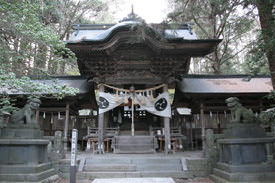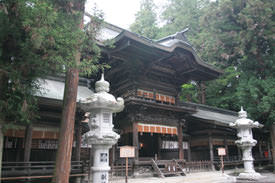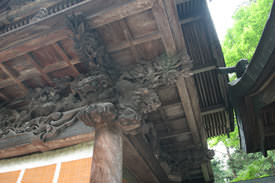亀原和太四郎の建築
Tachikawa-ryu was a prominent architectural school in Nagano Prefecture from the mid to late Edo period, leaving a legacy of works across Nagano, Kanto, and Kyoto. Notable works include Suwa Taisha Shimosha by Tomitake and the Musubiwake Shrine by Tomimasa in the Hokushin area.
The founder of the Tachikawa school, Tachikawa Washiro Tomitake, was born in 1744 as the second son of Tsukahara Chuemon Taigi, a bucket craftsman in the Suwa region. In 1757, he studied shrine and temple architecture under Okumaryu Tachikawa Kohei Tomifusa on the Tachikawa Street in Honjo. He was later permitted to adopt the Tachikawa name, receiving the character "Tomi" from Tomifusa, establishing the architectural carving school Tachikawa-ryu and adopting the name Washiro Tomitake.

Yabiko Shrine
At 23, Tomitake constructed the Juodo Hall in Kakumacho, Suwa. The Okumaryu school, known for its skilled shrine carvings, was active in Suwa at the time, prompting Tomitake to return to Edo to further study shrine carvings under Kotsune Furusawa in Ryogoku. Upon returning to Suwa in 1768, his first major work was Shiroiwa Kannon Hall, completed in 1774, marking the beginning of his expanding influence in the Suwa region.

Suwa Taisha Shimosha Harumiya
In its early years, the Tachikawa school focused on the Suwa area, but in the era of the second generation, Tomimasa, they expanded to more distant regions, creating buildings like Zenkoji Temple (1789) and Akiba Shrine (1796). When Shizuoka Sengen Shrine was rebuilt, it is said that Tachikawa Washiro from Suwa was tasked with preliminary work due to a lack of skilled sculptors in Suruga, following Tokugawa Iemitsu's original design.

Suwa Taisha Shimosha Akimiya
In 1802, Tomitake began working on carvings for Shizuoka Sengen Shrine, a project that spanned 40 years and was handed down to the second and third generations, Tomimasa and Tomitane, respectively. The Tachikawa school’s extensive work on this project included around 500 unique carvings. During this period, the reputation of the Tachikawa school spread, and they also crafted works for Toyokawa Inari in Aichi, Handa festival floats, and Takayama floats in Gifu.